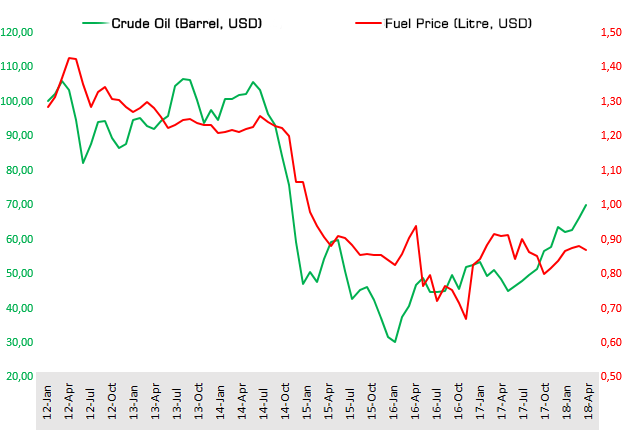Resume:
GEL exchange rate against USD peaked at the end of 2016 and reached 2.76 mark. In that period, USD index registered a growth, which was reflected upon global appreciation of USD against every other currencies of the world. Therefore, the Government of Georgia was devoid of any possibility to completely eliminate impact of USD appreciation and keep GEL exchange rate at the existing level. Difficult situation within the region in general and in partner countries has negatively impacted currency inflows as well as GEL exchange rate. The Government of Georgia was unable to seriously influence external factors affecting GEL exchange rate, although its certain actions (low economic growth rate, restricted visa regime with number of countries, unequal spending of state funds etc) significantly contributed to creation of some additional pressure against GEL exchange rate. Therefore, that part of the politician’s statement is mostly false.
Changes in GEL exchange rate against USD is reflected upon fuel prices. Even though fuel price in Georgia was more or less following the trend of changes in fuel prices across the world market, it still was not changing in similar proportion. This is because fuel import was getting expensive in that period as a result of GEL depreciation. However, since 2017, fuel prices in Georgia started to part ways with trends in oil prices at the world market which was caused by raise in excise tax rate in the same year. Immediately after raising excise tax, fuel prices increased by GEL 0.46 and of that amount, actual portion of excise tax is approximately GEL 0.18-0.22. In the past years, the lowest price on fuel was registered in July-December 2016, when average fuel price was GEL 1.75. The highest average price on fuel is registered this year.
Amendment in methodology of calculation of subsistence minimum and raising pension to the subsistence minimum level was one of Georgian Dream’s promises. Currently, old age pension in Georgia exceeds subsistence minimum by GEL 7 and constitutes GEL 180 (for pensioners living in mountainous regions pension is GEL 216), whilst it was GEL 110-125 in 2012. However, subsistence minimum calculation methodology has not been amended and calculation is still carried out by the methods employed before 2012. In 2018, state old age pension was not increased. Nika Melia’s criticism in this part of his statement is mostly true.
In regard to salaries of “high-ranking officials”, salaries of MPs has been increased by GEL 833 since 2018, whilst pay rise for state-level and political officials has been restricted by law. In addition, according to the same law, those individuals were forbidden to receive bonuses/supplements. Further, total labour remuneration to GDP ratio is decreased in 2018, whilst taken in absolute numbers there is no significant growth.
Given the aforementioned analysis, FactCheck concludes that Nika Melia’s statement is MOSTLY FALSE.Analysis
Georgian MP, Nika Melia, has talked about Georgian Dream’s performance. The MP stated that the Georgian Dream depreciated GEL to a historic minimum and increased fuel prices. At the same time, Nika Melia claimed that the Government of Georgia had promised to increase pensions but they failed to do so in 2018, whilst high-ranking officials all over the country were given a pay raise in the amount of GEL 700-800.
In the course of existence of Georgia’s national currency (since October 1995), highest exchange rate of GEL against USD was 2.78 which was registered on 21-22 December 2016, whilst the lowest exchange rate – 1.23 – was registered on 6 January 1996.
Graph 1:
GEL Exchange Rate Against USD, 1995-2017
 Source: National Bank of Georgia
Source: National Bank of Georgia
Speaking of reasons of GEL depreciation of note is USD index change impact upon GEL exchange rate. That index (DXY) indicates value of USD against the world’s six leading currencies. When index rises, USD appreciates and vice versa, when index declines USD undergoes depreciation. Usually, independent from Georgia’s other macroeconomic factors growth of USD index should result in GEL depreciation and when DXY decreases GEL is supposed to appreciate.
Graph 2:
Trend Changes of USD Index and GEL Exchange Rate, 1999-2018
 Source: Board of Governors of the Federal Reserve System (US); National Bank of Georgia
Source: Board of Governors of the Federal Reserve System (US); National Bank of Georgia
As illustrated by the graph, GEL exchange rate mostly follows USD index trend change. In other words, when USD used to appreciate against world’s other leading currencies, its exchange rate against GEL used to rise as well. USD appreciation, as a reason behind depreciation of GEL exchange rate, belongs to that group of factors, which cannot be influenced by the Government of Georgia. Since the end of 2014, USD index has been raising sharply, which causes significant depreciation of every other currency in the world, including GEL. However, temporary deviations from the tendency are visible and GEL exchange rate change amplitude is higher as compared to changes in USD index. This aspect implies that factors independent from global appreciation of USD (expectations, economic policy, regional processes) have also affected GEL depreciation and the Government of Georgia has leverage to respond to some of them. Therefore, it is impossible to strongly assert that the Government of Georgia is to blame for GEL depreciation. However, the Government of Georgia has to bear its own share of responsibility for GEL depreciation to some degree.
In regard to fuel prices after substantial drop in prices in 2016, since 2017 fuel prices have been rising rapidly, which is partly caused by increased excise tax rate on petrol products and partly because of growing oil prices at the world market. In the end of 2016, when the excise tax rate has not yet been increased, average fuel price was GEL 1.77. In January 2017, after imposing new excise tax rate, fuel price immediately increased by GEL 0.46 and of that amount, GEL 0.18-0.22 accounts for increased excise tax rate alone. Of note is that in time of Nika Melia’s statement, highest average price on fuel –GEL 2.34 – was registered in 2012. However, in July average fuel price reached GEL 2.46, which constitutes a new historic maximum.
Graph 3: Fuel Price (GEL)[1]
in 2012-2018
 Source: Gulf Petrol Station
Graph 4:
Source: Gulf Petrol Station
Graph 4: Average Fuel Price in Georgia and Average Crude Oil Price in the World
 Source: Gulf Petrol Station
Source: Gulf Petrol Station
To summarize discussion on fuel prices, it needs to be added that rise in fuel prices is mostly related to increased oil prices at the world market. However, the Government of Georgia again has its own share in making fuel prices more expensive. As we have already mentioned, this is because of rise in excise tax rate in 2017, which increased fuel prices by nearly GEL 0.18-0.22.
In regard to pensions, old age pension in 2012 was GEL 110 and GEL 125 respectively. After change of government, pension increased multiple times. In 2013, pension for every pensioner increased to GEL 125 which was later reached GEL 150. In 2015, pension was increased by GEL 10 (up to GEL 160) and since July 2016, old age pension has been GEL 180. Since then, pension has not been increased. However, pensions for pensioners who live in mountainous areas have been increased to GEL 2016 since September 2016.
Of note is that one the campaign promises of the Georgian Dream in 2012 was to increase pensions to the level of subsistence minimum. As of today, existing old age pension exceeds subsistence level (GEL 173) by GEL 7. Although, the promise incorporated changes in methodology of calculation of subsistence minimum, because the Georgian Dream believed that subsistence level is much higher as compared to what is calculated by the National Statistics Office of Georgia. However, subsistence minimum was not calculated anew. FactCheck wroteabout that fact in 2016 too. Therefore, Nika Melia’s pretension in regard to pensions is mostly legitimate.
In regard to pay raise for high-ranking officials, the latter term (used by Nika Melia) is not legally defined, however the statements include state-level and political figures such as: President, MPs, ministers and their deputies, governors and their deputies, official figures in Ajaria Autonomous Republic, city council officials, mayors and their deputies etc. FactCheck has published multiple researches in regard to labour remuneration of the aforementioned figures (see link 1, 2, 3, 4). Since 1 January 2018, salary of all MPs (including the MPs with parliamentary positions) has been increased equally by GEL 833. In case of other state-level and political officials, it needs to be clarified that the aforementioned individuals used to receive salary, salary supplement and bonus as a labour remuneration. Since 2018, in accordance with the new law, state-level and political officials receive only salaries only and no other remuneration (bonuses, supplement). The law has also limited growth of their salaries and maximum salary received in 2017 was determined to be a ceiling. In turn, as of 2015, labour remuneration of the ministers and their deputies had been reduced by 24% as compared to 2012. Amount of labour remuneration for the ministries was also cut this year. Expenses for labour remuneration were also cut at State Trustee – Governors’ administrations, whilst salaries of governors have not been increasedsince 2018.
[1] Graph is drawn based on monthly average prices

















